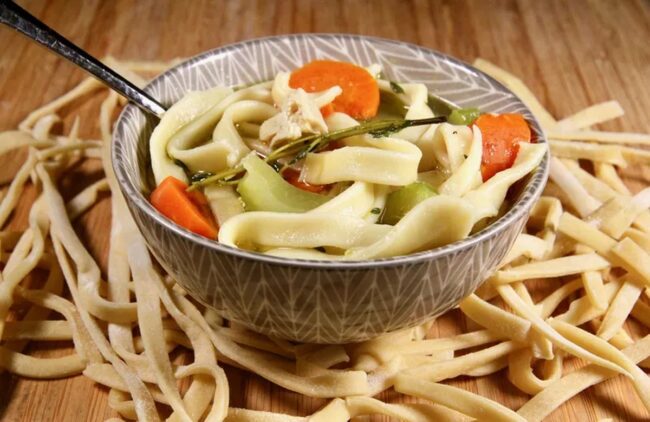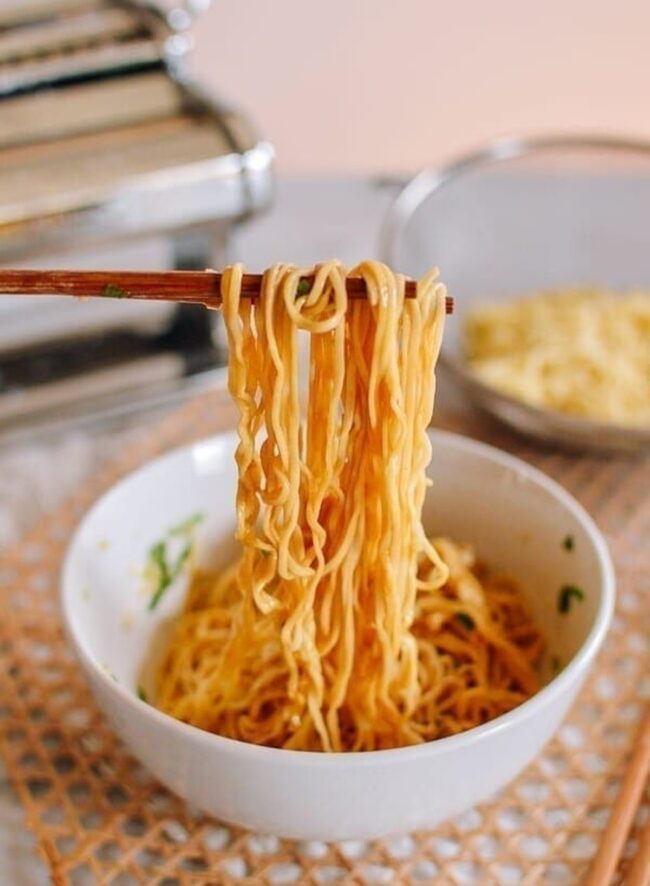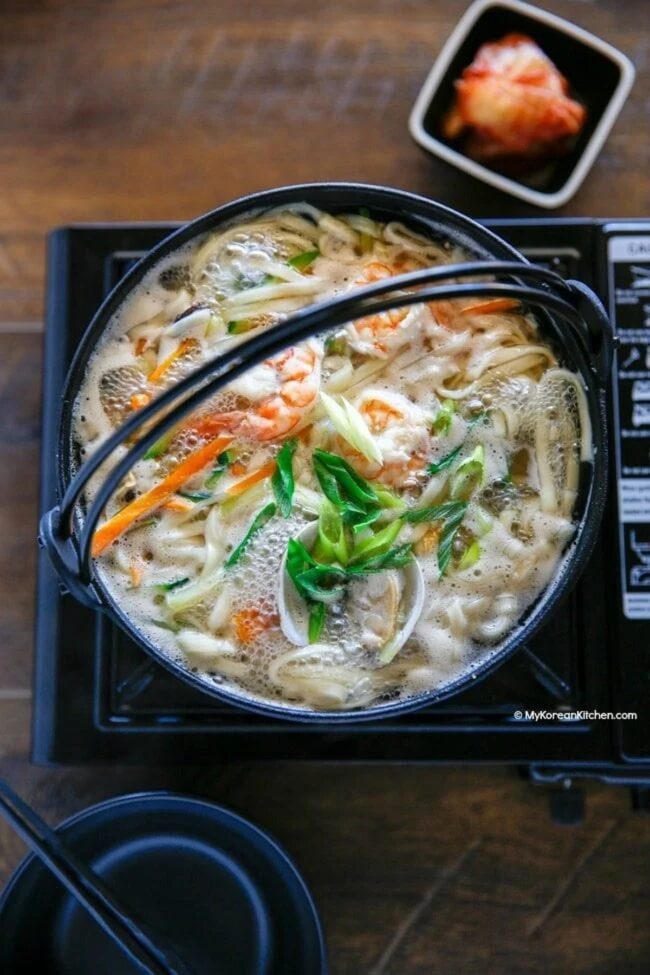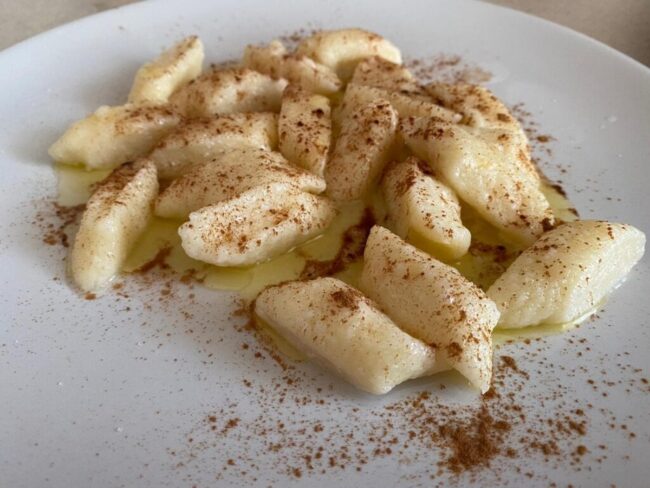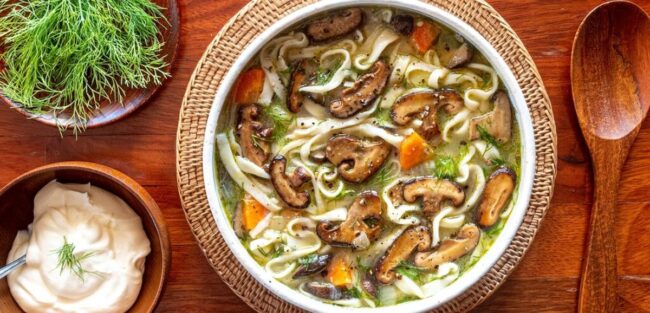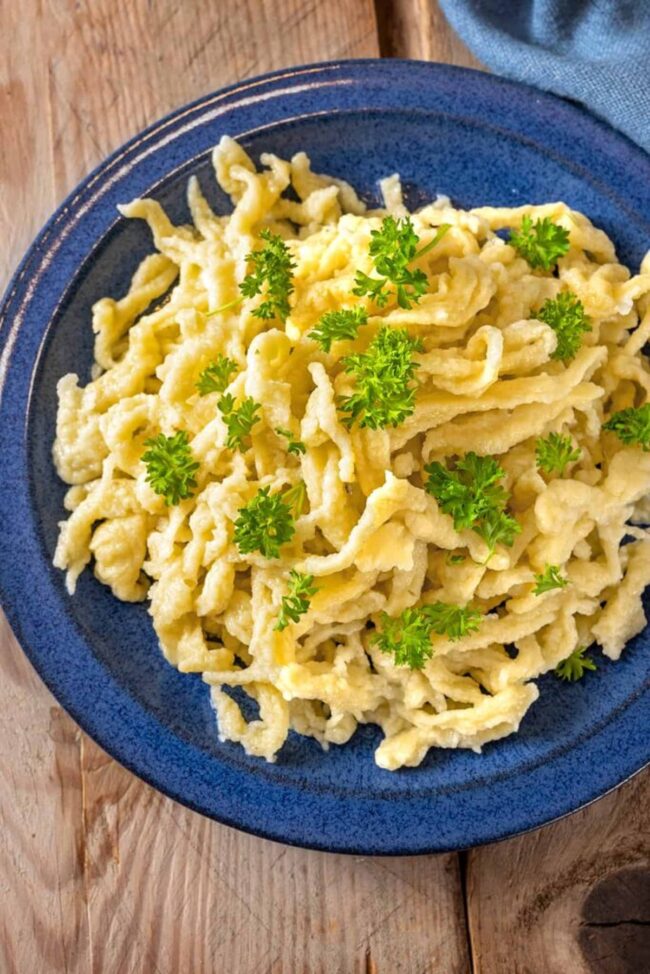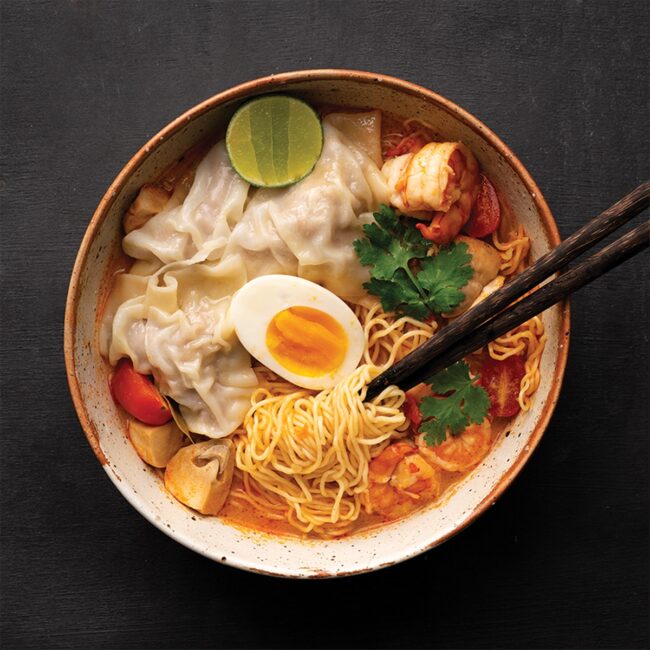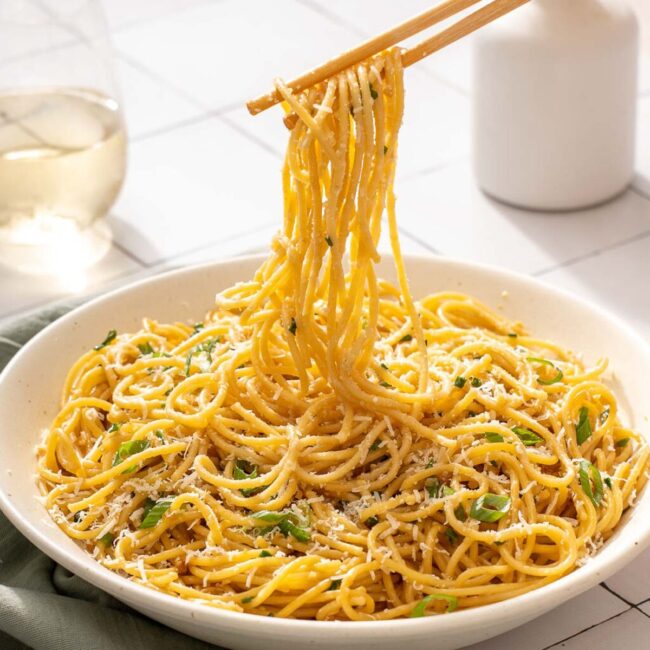10 Classic Egg Noodles Recipes You’ll Love
Egg noodles recipes capture comforting, homemade flavors in each bowl.
Simple basics like flour, eggs, and a pinch of salt create tender, chewy noodles.
Rolling and cutting the dough produces perfect strands for soups and stir-fries.
Traditional methods connect past generations of cooking wisdom.
Traditional Egg Noodles Recipes for Authentic Comfort
Egg noodles bring traditional flavors and textures to a wide range of dishes. Homemade or store-bought, they work beautifully in soups and stir-fries.
Homemade Egg Noodles
Fresh egg noodles bring a delightful twist to many meals.
Only four ingredients are needed: flour, eggs, salt, and water.
Combine these items to create a smooth dough and allow it to rest briefly for better texture.
Rolling the dough thinly on a floured surface makes cutting into strips easy for noodle shapes.
These can be cooked immediately or dried for later use; fresh noodles cook faster than their dried counterparts.
Adding homemade noodles enhances soups and stews or pairs wonderfully with butter and cheese, elevating any dish with personal flair.
Traditional Chinese Egg Noodles
Chinese egg noodles play an important role in many meals.
These noodles offer a satisfying chewiness that complements both soups and stir-fries beautifully.
Making them at home is simple; just gather flour, eggs, water, and salt.
After mixing the ingredients to create dough, knead it until smooth and let it rest for half an hour.
Roll out the dough thinly before cutting it into strips for cooking or drying later on.
Adding homemade egg noodles enhances dishes like lo mein or chicken noodle soup with a taste that's richer than what store-bought options provide.
Japanese Ramen Egg Noodles
Beloved in Japan, ramen egg noodles offer a delightful experience.
Boiling eggs for 6-8 minutes yields a soft, jammy yolk.
While cooling the eggs, prepare a marinade using soy sauce, mirin, and water.
After peeling the eggs, let them soak in the marinade inside the fridge for about 8-10 hours to absorb flavors.
Cooking ramen noodles involves boiling water and following package instructions closely before mixing them with your chosen soup base.
Topping this dish with marinated egg halves and optional ingredients like chashu pork or fresh vegetables elevates it to a complete meal full of taste and texture.
Korean Kalguksu
A warm bowl of kalguksu offers comfort on chilly days.
This Korean noodle soup features handmade noodles crafted from flour, salt, water, and oil.
After mixing these ingredients together and kneading until smooth, resting the dough is essential before rolling it out thinly.
Cutting the rolled dough into strips forms the noodles that cook swiftly in a rich broth made with anchovy, kelp, and fresh vegetables like zucchini, carrots, and mushrooms.
Once ready to serve hot bowls of kalguksu topped with green onions bring happiness to any meal.
Enjoying this dish feels like a warm embrace for your taste buds.
Italian Pasta di Mandorla
These Italian almond cookies, known as Pasta di Mandorla, have a delightful combination of textures.
A crispy outside contrasts beautifully with a chewy center.
The sweet flavor of almonds shines through in every bite, making them an excellent match for coffee or tea.
Popular in Sicily, these treats are now enjoyed all over Italy and can often be found in local bakeries.
Creating them at home is simple with just a few ingredients: almond flour, sugar, egg whites, and lemon zest mixed into soft dough.
Forming small balls from the dough before baking yields lightly golden edges while keeping the centers soft and inviting.
Polish Kluski
Kluski, the delightful Polish egg noodles, shine with their soft texture and mild flavor.
Mixing flour, eggs, and salt creates the foundation for this dish.
Adding water gradually leads to a smooth batter ready for cooking.
A pot of salted water simmers as small spoonfuls of the batter are dropped in.
Cooking continues until they float to the top, signaling they are done.
Versatile Kluski work well as a side or in soups and stews; adding herbs or spices can introduce exciting flavors to this comforting meal.
Russian Lapsha
Cooking Lapsha brings a taste of tradition right into your kitchen.
This classic dish features egg noodles made from simple ingredients like flour, eggs, water, butter, and salt.
Start with a large bowl to mix the eggs and salt together.
Gradually add warm water mixed with butter while whisking until smooth.
Flour blends in slowly; incorporate it half a cup at a time while kneading the dough on a floured surface for around ten minutes to create that perfect texture.
After forming orange-sized balls from the dough, roll them out thinly and cut them into strips before allowing them to dry slightly before boiling in water until tender.
Enjoy Lapsha as an addition to soups or paired with delicious sauces for variety at mealtime.
German Spatzle
Small and irregularly shaped, German Spätzle are beloved egg noodles from Southern Germany.
Making them requires a few basic ingredients: flour, eggs, salt, and either water or milk.
After mixing these together into a smooth dough, letting it rest for ten minutes is important.
A pot of salted water should simmer nearby while preparing the noodles.
Pushing the dough through a Spätzle maker or colander allows it to drop directly into the simmering pot; once they float to the top after a few minutes, they are ready to eat.
Serving them as a side dish works well or tossing with butter and herbs creates an easy yet tasty meal option.
Thai Egg Noodle Soup
Khao Soi is a delicious egg noodle soup from Northern Thailand.
The rich coconut curry broth pairs wonderfully with the soft noodles.
First, sauté curry paste in oil to release its flavors, then mix in coconut milk and chicken broth for the base.
Cook egg noodles separately and place them into bowls before pouring the hot broth over them.
For added protein, include pieces of cooked chicken in each bowl.
Crispy fried noodles, lime wedges, and chopped cilantro on top provide a delightful crunch and fresh taste to this hearty meal.
Vietnamese Egg Noodles
Crispy Vietnamese egg noodles create a delightful meal that many enjoy.
Toppings like shrimp, scallops, bok choy, and mushrooms add richness to the dish.
A savory sauce enhances the flavors beautifully.
For Mi Xao Gion, frying the noodles in hot oil results in a perfect puffed texture; each side needs about 4-6 minutes for optimal crispiness.
Mi Xao Mem offers another option with stir-fried garlic, carrots, and celery combined with soy sauce and oyster sauce for added depth of flavor.
This dish appears in various recipes showcasing its versatility and appeal across different palates.
Egg Noodle Key Ingredients
Egg noodles are made with simple ingredients that create a rich texture. The right balance ensures a soft and chewy bite.
Best Flour Picks
Using all-purpose flour makes excellent egg noodles.
Choosing unbleached flour adds a more natural taste.
For firmer noodles with a satisfying bite, semolina flour works wonderfully.
Combining different flours can lead to your perfect noodle blend; mixing two parts all-purpose with one part semolina is worth trying.
Sifting the flour beforehand ensures smoothness by removing lumps, enhancing the final texture of the noodles.
Enjoy experimenting until you discover your favorite mix!
Fresh Egg Benefits
For making delicious egg noodles, fresh eggs play an important role.
The rich flavor and vibrant color they offer enhance the final product.
Opt for large eggs that are at room temperature; this choice allows for better mixing with flour.
Bright yolks from farm-fresh eggs lend a lovely golden shade to the noodles.
Cracking the eggs into a separate bowl first helps avoid any shell fragments in your dough, ensuring a smooth texture.
Lightly beating the eggs before combining them with flour results in an even mixture throughout your dough.
Extra Ingredient Tips
Resting the dough after mixing is crucial.
This step helps gluten develop, making it easier to roll out later.
Salt plays an important role in enhancing the flavor of egg noodles; about 1/2 teaspoon for every cup of flour works well.
A splash of water can assist in bringing the dough together, but adding it gradually is key to prevent excess moisture.
For a more flexible texture, incorporating a bit of olive oil into the mix can be beneficial.
Using extra egg yolks instead of whole eggs creates richer noodles; two yolks replace one whole egg effectively while avoiding milk or cream keeps them from becoming too soft.
Make Egg Noodles Traditionally
Traditional egg noodle recipes focus on fresh ingredients and simple steps. Making them from scratch enhances flavor and texture.
Dough Kneading Guide
Kneading the dough on a floured surface for around 10 minutes develops gluten, giving the noodles their chewy texture.
After that, letting it rest for 30 minutes allows the dough to relax and simplifies rolling.
The next step involves rolling out the dough into a thin sheet about 1/8 inch thick.
If stickiness occurs, adding more flour can help manage it easily.
For those who prefer extra-thin noodles, utilizing a pasta machine is an excellent choice; begin with the widest setting and gradually adjust to thinner ones.
Mixing flour, eggs, salt, and water in a bowl starts this delicious process.
Perfect Noodle Cutting
Start by folding the rolled dough sheet loosely.
A sharp knife works well for cutting it into strips, with width based on personal preference, narrow for light soups or broader for filling meals.
For those who want even noodles, a pizza cutter glides effortlessly and provides neat edges.
Unfolding the strips immediately helps avoid sticking together, and tossing them with a little flour keeps them apart.
Some chefs recommend letting the dough dry slightly before slicing; this method can simplify cutting and enhance noodle shape retention.
Homemade Noodle Storage
Dried noodles have a longer shelf life, making them more convenient for meal planning.
Air drying requires hanging the noodles on a rack or clean clothes hangers, or spreading them out on floured baking sheets.
After 1-2 hours of drying, they should feel leathery without becoming hard.
Once dried properly, store these noodles in airtight containers to maintain freshness; they last about a week at room temperature and up to one month in the fridge.
For even longer storage options, freezing in ziplock bags keeps them good for three months.
Freshly made noodles can be cooked immediately but benefit from this preservation method for later use.
Egg Noodles: Cook and Serve
Cooking and serving egg noodles properly brings out their best texture. Simple techniques help create delicious meals.
Boiling Noodle Tips
Cooking noodles can be a simple yet satisfying task.
Start by bringing salted water to a vigorous boil in a large pot.
Adding the noodles requires gentle stirring to avoid sticking, with cooking lasting 3-5 minutes until they reach that perfect tender but firm texture.
Testing for doneness involves biting into one; it should feel slightly firm, known as al dente.
Once ready, draining them in a colander follows, and rinsing with cold water is essential if they will feature in chilled dishes.
For added flavor during cooking, broth serves as an excellent alternative to plain water while including some oil helps keep the noodles separate and smooth.
Classic Sauce Pairings
A hearty Bolognese or meatball sauce complements egg noodles beautifully.
Creamy Alfredo sauce clings well to the noodles, providing a rich flavor.
For those craving something different, an Asian twist includes tossing the noodles with soy sauce and sesame oil, along with green onions.
Adding cooked chicken or shrimp turns this into a satisfying dish.
Simple butter combined with herbs like parsley and garlic creates a delightful coating for hot noodles as well.
These versatile options highlight how egg noodles can adapt to various tastes and styles in cooking.
Creative Pasta Serving
Noodle fritters offer a crispy treat by combining cooked noodles with eggs and herbs, then frying them into golden patties.
Cold noodle salad provides a refreshing option, mixing chilled noodles with colorful veggies and aromatic herbs, dressed in tangy sauce.
Egg noodles serve as the perfect base for casseroles, layered with cheese, vegetables, and meat for a hearty meal that warms the soul.
Twirling cooked noodles into small nests creates an appealing presentation topped with meatballs or other proteins.
Stir-frying offers quick satisfaction; toss your favorite veggies and protein together while adding soy sauce and ginger for extra flavor enhancement.
Each dish presents unique tastes that can elevate any dining experience.

